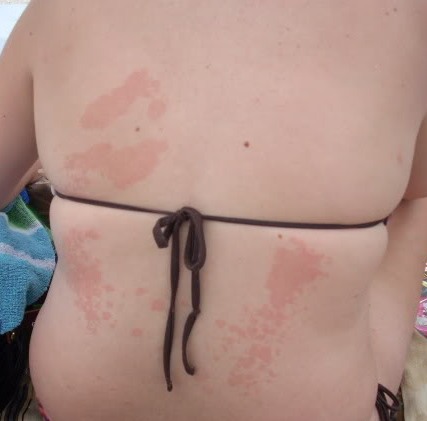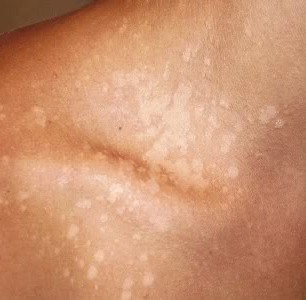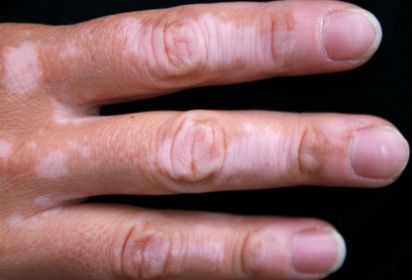
We’re going to show you some tinea versicolor pictures so you can see what the condition looks like. While it’s not an extremely rare condition, it’s not so common that everyone knows what it looks like, either. It’s possible you’ve never seen it before.
People in tropical and subtropical climates are most likely to get tinea versicolor, although people in other geographical locations can get it, too. Unlike many fungal infections, tinea versicolor is not contagious. Doctors aren’t always sure what causes the yeast to begin to overgrow but people with oily skin and people that sweat a lot are more likely to get it. Since teens and young adults are more likely to have oily skin, they are more likely to suffer from tinea versicolor, although people of any age can get it. People with weakened immune systems are also more susceptible to the condition.
In addition to helping you recognize tinea versicolor when you see it, we’ll tell you how to treat it and tell you about our preferred tinea versicolor medication.
What Does Tinea Versicolor Look Like?
Tinea versicolor, sometimes called pityriasis Versicolor, is a fungal infection of the skin. Yeast, which is a type of fungus, lives naturally on our skin. Tinea versicolor is a condition that occurs when that yeast grows out of control. It happens most often in hot, humid weather because the yeast flourishes in such conditions.
The infection initially appears as small discolored spots on the skin, which may grow and merge into larger discolored patches. The spots or patches may be lighter or darker than your normal skin tone and may be white, red, pink, tan, or brown in color. These spots or patches may appear anywhere on the body and the skin may look dry or scaly.
Sometimes the spots are very faint so they are difficult to see. Over time, they usually become more obvious. The spots are often very itchy.
Tinea Versicolor Pictures
Here are some pictures of tinea versicolor so you can see how it might look. Notice how the size of the discolored patches varies and how the colors vary, as well.
The spots from tinea versicolor may become more noticeable when a person tans because the yeast prevents the affected spots from getting tan. The spots may disappear in autumn and winter, when the air is cooler and drier, and reappear in spring and summer when the air is warmer and more humid.
 Tinea Versicolor Tinea Versicolor |  Tinea Versicolor Tinea Versicolor |
When the spots on the skin are very light, the condition may be mistaken for vitiligo, according to the American Academy of Dermatology. Vitiligo is a skin condition in which the cells that produce melatonin, the pigment that gives skin its color, stop functioning, or die. It causes light patches on the skin. It’s not caused by a skin fungus, though. Vitiligo is not itchy like tinea versicolor is, either. Finally, it usually, though not always, appears before the age of 20. Compare this picture of vitiligo to these tinea versicolor pictures to see how they might look similar.

If you’re not sure if you’re dealing with tinea versicolor or vitiligo, see your doctor. Doctors can often make a diagnosis just by looking at your skin but if not, they can take a small scraping of the skin and examine it under a microscope. Don’t try to diagnose yourself based on these tinea versicolor pictures. The information provided here is not meant to be a substitute for medical advice.
Treating Tinea Versicolor
Tinea versicolor is treated with antifungal medication. Topical formulas that you apply to your skin are available over the counter or by prescription. Antifungal pills that you swallow are also available by prescription. Often, over-the-counter topical medications are sufficient, but you should see your doctor if your condition does not improve with over-the-counter treatments. Even after the fungal infection has been treated, your skin may still have discolored patches for a while since the fungal infection interferes with the normal pigmentation of the skin (1).
Top Recommended Tinea Versicolor Medication
Our top recommended treatment for tinea versicolor is actually a combination approach. Naturasil Tinea Versicolor Medicated Soap contains FDA-registered homeopathic antifungal ingredients that cleanse your skin and help rid the skin of yeast. Naturasil for Tinea Versicolor Treatment is a liquid homeopathic medicine that kills fungus on contact. Used together, the medicated soap and the liquid medicine fight the fungus that causes tinea versicolor and help relieve the itching caused by the condition. To learn more, just follow the links.
(1) Mayo Clinic: Tinea Versicolor Treatment
